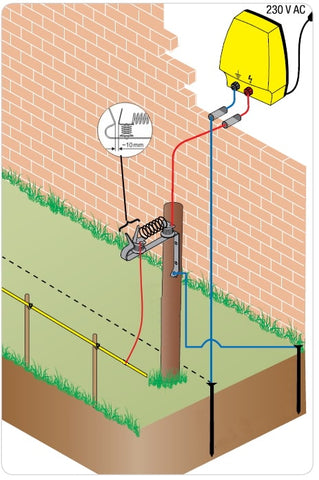You have no items in your shopping cart.
There is nothing more of a hassle, than testing your electric fencing the morning after a lightning storm and finding your energiser burnt to a frazzle. Trying to outsmart Mother Nature can be almost impossible, but there are a few tricks. You cannot guarantee absolute lightning protection, but you can install safeguards such as surge protectors and lightning protection to help avoid an expensive repair.
Lightning strikes are not very common in the UK but there are areas where a fence going over the top of a hill through an open field may be more susceptible. In fact, lightning rarely strikes a fence. Instead the lightning induces voltage on the fence line, and can happen even when lightning strikes a fair distance away from the fence. This type of energy induction can reach your fence as often four times a year.
Lightning will always seek out the path of least resistance on its way to the ground. As such, fences with hundreds or thousands of feet of metal wiring in them make excellent conduits for the electricity blasted out of the sky in the form of a lightning bolt.
As the energy from induced lightning travels along the fence, it seeks out a path that will deliver it into the ground while expending the least amount of energy. In the case of an electric fence, that path will be through its earth stake system, which is on the “opposite side” of the fence energiser. That means if induced lightning hits an electric fence, it must travel through the energiser to get to the ground rods. This route can cremate the fence energiser in the process.

Installing a mechanical Lightning diverter is simple and highly effective. Lightning (electricity) is always looking for a ground connection and all you need to do is protect the energiser by creating a route to ground. This is achieved by inserting a resistor coil in the live fence line between the energiser and the fence. This coil allows the current from the energiser to go to the fence and creates a magnetic field around the coils but when the very high voltages common with a lightning strike attempts to reverse the current, it creates a resistance caused by the coils inertia. This resists the flow of electricity and tries to reverse the magnetic field forcing the strike to look for a bypass, this is available by the steel plate connected to the earth stake and separated from the coil by an air gap (about 10 mm but must be set for individual energisers) sufficient to only just prevent the normal energiser current to jump it. The Lightning strike with its' very high voltage will then jump this gap and travel safely to ground. This gap may be set by switching on the energiser so that it is working normally, push gap closer until the energy is able to jump the gap and them open the gap until it stops arcing.
A schematic diagram below will show how simple the diverter is to install. A switch is supplied so that it is easy to isolate the energiser should a storm be brewing allowing you to completely isolate the energiser but still be able to divert the energy to earth.
This will give 75-90% protection and this level will be increased by including a second diverter to near on 100%. Whilst the setup will work when connected to the fence line earth stake, it is preferable to supply a separate earth stake to isolate the system completely.










← Older Post Newer Post →
0 comments